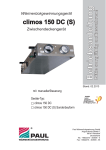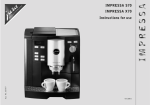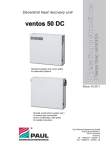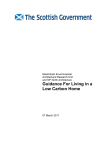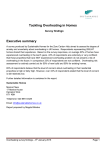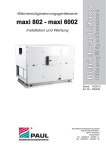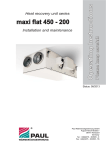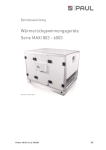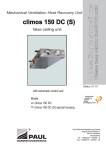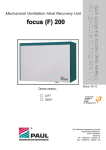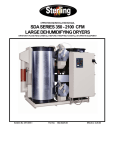Download Operating Instructions Operating Instructions
Transcript
Please keep next to the MVHR unit! multi 100/150 DC Operating Instructions Mechanical Ventilation Heat Recovery Unit Status: 06.09 Components suitable for Passive House Dr. Wolfgang Feist with manual operation Device-type: Q multi 100 DC Q multi 150 DC ® WÄRMERÜCKGEWINNUNG Paul Wärmerückgewinnung GmbH August-Horch-Straße 7 08141 Reinsdorf Deutschland Tel.: +49(0)375 - 303505 - 0 Fax: +49(0)375 - 303505 - 55 Contents Part A Instruction Manual Page 1 0. Introduction . ....................................................................................................... 1. 1.1 1.2 1.3 1.4 1.5 1.6 1.7 1.8 1.9 Brief description .................................................................................................. Equipment configuration Housing, heat insulation, sound absorption Heat exchanger Summer box Ventilators/fans Filter Operation Limits ................................................................................................. Combustibility Anti-freeze 2. 2.1 2.2 Options and additional functions ........................................................................ Options Additional functions 2 3. 3.1 3.2 3.3 Assembly instructions ........................................................................................ Assembly of the heat recovery device (WRG) – attaching the air ducts Power supply / Electrical operation ..................................................................... Attachment and maintenance of the condensation discharge hose G ¾” 2 4. 4.1 4.2 4.3 Start-up .............................................................................................................. Readiness for operation Setting the air volume flow rate Adjusting the valves (incoming air and exhaust air) 4 5. 5.1 5.2 Maintenance and repairs by owners (users) ...................................................... General information Changing filters 5 6. Maintenance and repairs by technical staff ...................................................... 5 1 2 3 Part B Instruction manual for operation 1. 1.1 1.2 1.3 1.4 1.5 1.6 1.7 1.8 1.8.1 1.8.2 1.8.3 1.8.4 1.9 Manual operation ................................................................................................ Ease of use Description of operating possibilities Fan stages Speed monitoring Draught ventilation Suitability of chimney ......................................................................................... Filter duration Control inputs Digital inputs Clock timer Anti-freeze, analogue input Release relay Display of the operational and error status ....................................................... Appendices Appendix 1 Clamping plan for manual operation multi 100/150 DC Technical Data multi100 DC Technical Data multi150 DC Checklist A maintenance work by owners/users Checklist B by technical staff Record of air volume flow rate 1 2 3 Status 24.06.09 We reserve the right to make changes favouring technical progress. Instruction manual multi 100/150 DC manual operation 0. INTRODUCTION PLEASE READ THIS MANUAL CAREFULLY BEFORE START-UP! This manual contains all the required instructions for an optimal assembly of a unit and the heat recovery device (WRG) of the type multi 100/150 DC. It also serves as a guide for maintenance and customer service work. Using this manual, you can learn how to easily use your heat recovery device in as optimal a way as possible. In case you have to do any work inside the device we recommend taking the advice of the installation company. The device is subjected to continuous improvement and further development. It is possible, therefore, that your device differs slightly from the description. We hope you enjoy using your WRG multi 100/150 DC. PLEASE NOTE: Great care has been taken in preparing this manual. However, you are not entitled to any rights through its use. We reserve the right to modify the content of this manual, partially or completely, at any time. 1. Brief description 1.1 Equipment design The compact heat recovery device (WRG) is ready to be connected and consists of an actual heat recovery device, the control unit and the operating element belonging to it. The WRG is connected to the control unit with a 3 m long cable. The cable for connecting the operating element to the control unit can be max. 15 m long and as with the power supply for the control unit, must be provided by the customer. 1.2 Housing, heat insulation, sound absorption The cabinet is made of galvanised, white powder coated steel sheets with inner heat insulation and sound absorption (see Technical Data for exact structure). We recommend attaching one sound absorber each (or 1...2m sound insulated flex hose 125 or 160 in diameter). The air ducts should be flexible. 1.3 Heat exchanger The highly efficient reverse flow channel heat exchanger (German and European Patent) has been built in such a way that the channels (plastic) are arranged in a chessboard pattern and a duplication of the heat exchange surface compared to plate heat exchangers is thus achieved; the two media (exhaust air and incoming air) are hermetically separated from each other. 1.4 Summer box The summer box replaces the heat exchanger package in summer. The two air flow directions pass by each other without heat transmission in this way. 1.5 Ventilators/fans The device contains two maintenance-free electronically commutated 48 V DC radial ventilators with blades bent backwards. When ventilation is normal, a specific energy consumption of 0,36 Wh/m³ (passive house quality certificate) is reached. The air volume flow rates can be varied by the user. Please observe here, that if there are a few people and a short duration of stay, less CO2, air moisture and smells are emitted into the room and the air quantity can thus be intensely reduced. When outside temperatures are cold (dry outside air), room air conditions that are too dry can be avoided. 1.6 Filters 2 Filters in a Z design of the filter type G 4 (house dust filter) are installed in the device. They are made out of a mixed cotton/polyester fibre in a cardboard frame. A high grade pollen filter (filter type F 8) can be used optionally as an incoming air filter. Filter monitoring takes place through the electronic control unit using checking of duration (see point 5.2). © Paul Wärmerückgewinnung GmbH • August-Horch-Straße 7 • 08141 Reinsdorf • Deutschland Tel: +49(0)375-303505-0 • Fax: +49(0)375-303505-55 • E-Mail: [email protected] • Internet: www.paul-lueftung.de 1 Status 24.06.09 We reserve the right to make changes favouring technical progress. Instruction manual multi 100/150 DC manual operation 1.7 Operation limits The WRG has been designed for the suctioning of used air and introduction of fresh, temperate outside air. Any other usage is contrary to these intentions. The manufacturer is not responsible for damages or consequences resulting from usage for purposes other than those intended. The device can be used for ventilation in the living and office areas (limited use in commercial spaces) at air temperatures up to + 40°C and normal air moisture. Explosive and aggressive gases as well as solvents that attack the materials the device is made of cannot be used on the device. The device must be set up in a frost free room. A soil heat exchanger is of advantage to pre-heat the external air (winter). If this is not possible, defroster heating (please enquire) must be connected to it in series. 1.8 Anti-freeze An anti-freeze switch serves as an anti-freeze measure to protect the device and functions by speed reduction of the incoming iar ventilator (see instruction manual, operation, Pt. 1.7.3) This frost protection cannot be used together with a chimney. The anti-freeze element in the device should also be guaranteed as follows: a) Defroster heating with independent operation (Option), or b) Soil heat exchanger (Option). The WRG multi 100/150 DC can additionally be used (option) with an anti-freeze switch suitable for chimneys. 1.9 Combustibility The device housing is made up of steel sheets. The installed parts are made of not easily inflammable polystyrene (Fire type B1). Other components are not easily inflammable or normally inflammable (heat exchangers, ventilators); the filter with a cardboard frame (combustible) can be classified as a subordinate component. The device thus complies with regulations stipulated by the buildings authorities. 2. Options and additional functions 2.1 Options (for additional explanations, see the instruction manual for operation) • Suitability of chimney (additional configuration software) • Clock timer (can be integrated into the PEHA switch programme analogous to the plastic film keyboard element) • External draught ventilation key 2.2 Additional functions (for further explanations, see instruction manual for operation) • Draught ventilation with external key • External OFF switch • Free switch contact 3. Assembly instructions 3.1 Assembly of the heat recovery device (WRG) – connecting the air ducts The WRG device should preferably be mounted in a vertical position to guarantee a better discharge of the condensation fluid, but horizontal installation is possible. PLEASE NOTE: Devices meant for horizontal assembly cannot be mounted vertically and vice-versa. In the case of horizontal assembly the device should not be placed directly on to cabinets, but should be attached separately, with the clamps made available for holding it. ATTENTION: To enable the condensation fluid to drain off, the WRG device should be mounted with a slight incline to the escaping air pipe and the rear of the cabinet (towards the condensation discharge) when being mounted horizontally. This can be achieved by placing base plates in front of the two lower fastening clamps of the device. Please make sure it is easily accessible for changing of filters and maintenance. Connecting the air ducts – rectangular air ducts 205 x 60 as per equipment design To enable easy assembly, the air duct connections should be made with flexible air hoses. Apart from the possibility described under point to, you can also to pull a special insulating hose covered with aluminium over the flexible rectangular hose to ensure good sound absorption (length 1..2m). The air ducts must be insulated in the following areas with 50 mm insulation: © Paul Wärmerückgewinnung GmbH • August-Horch-Straße 7 • 08141 Reinsdorf • Deutschland Tel: +49(0)375-303505-0 • Fax: +49(0)375-303505-55 • E-Mail: [email protected] • Internet: www.paul-lueftung.de 2 Status 24.06.09 We reserve the right to make changes favouring technical progress. • • • • Instruction manual multi 100/150 DC manual operation Ducts emitting cold air into warm rooms (airtight masking of insulation!) Ducts emitting warm air into cold rooms, if available: Defroster heating Air heater for subsequent heating of air 3.2 Power supply / Electrical operation The WRG multi 100/150 DC is connected to the control unit with a 3 m long control cable. The control panel is connected to a socket with 230 VAC 50 Hz using a mains supply cable, which must be available at the place where the control unit is being assembled. Please note: • The control cables for operating elements and sensors cannot be laid out right next to 230/400 VAC lines (minimum space 20 cm) and cannot be laid out in loops. • The control unit must be mounted in such a way that heat accumulation is avoided and accessibility for servicing is ensured. When you are mounting it, please make sure that the control element is not encased or enclosed ( e.g. „concealed“). 3.3 Connection and maintenance of the condensation discharge hose G ¾” The condensation discharge hose must be laid out all over in an inclined position (min. 5%). The diameter should not be reduced. The condensation liquid should be able to drip off freely at the end, so that the hose is emptied completely. If there is a risk of rust, this hose must be heated (accompanying heating hose can be supplied). If a vertical or horizontal air duct is mounted on the pipe connected for escaping air, a condensation discharge outlet must also be attached at the bottom of it. Lay out the condensation pipes in a frost free place! Fig. 1 Please note: Siphons can dry up! They should always be filled with water, when: • the device is being started up • the siphon makes noises (slurping noises) • the building’s sewage system emits smells • air starts flowing out of the siphon • a dry siphon is recommended and can be supplied (no smell is emitted into the air when it dries up) If a low point cannot be avoided when laying out the pipe for escaping air from the device’s connecting pipe for escaping air to the wall outlet, a further connecting pipe for the transmission of the condensation must be connected there, since the escaping air is saturated with steam when outside temperatures are cold and there is precipitation in the form of drops on the inner walls of the pipe. If you plan to attach a sound absorber on the connecting pipe for escaping air, this must be arched upwards(∩) to protect it from getting drenched by the condensation flowing back from the pipe for escaping air. The device should be set up in such a way that the condensation discharge can flow over a long, well inclined stretch. © Paul Wärmerückgewinnung GmbH • August-Horch-Straße 7 • 08141 Reinsdorf • Deutschland Tel: +49(0)375-303505-0 • Fax: +49(0)375-303505-55 • E-Mail: [email protected] • Internet: www.paul-lueftung.de 3 Status 24.06.09 We reserve the right to make changes favouring technical progress. Instruction manual multi 100/150 DC manual operation 4. Start-up 4.1 Readiness for use • Establish a connection to the mains • Fill syphon with water • Switch device to medium fan speed (e.g. level 5) 4.2 Setting of the air volume flow rate The air volume rate is set through the ventilator speed. (For factory setting, see Technical Data Characteristic curves-). In accordance with the pipe layout (loss of pressure in all lines is the same, e.g. 100 Pa) and the required total volume flow rate, the appropriate characteristic setting for normal ventilation (e.g. 70% or point 5) must be selected from the technical data of the device and the ventilation speed must be set on the operating element. The volume flow rate of incoming and exhaust air can be set differently, e.g. when using a soil heat exchanger the speed of the incoming air ventilator must be increased above the corrected speed under if necessary (For procedure: see instruction manual for manual operation). The volume flow rate of the incoming and exhaust air is balanced out through the network of channels. 4.3 Adjusting the valves (incoming air and exhaust air) • Set ventilators to medium using the operating element • Adjusting the air volume flow rates on the air valves using the volume flow hood and anemometer (see the recorded air volume rate) • Do not set too narrow an air gap on the valve – there will be noises in the air! It is better to decrease the ventilator speed or reduce the volume flow rate in the pipe itself (install a throttle valve or foam throttle) • Adjustment of air volume flow rate on the device (if required). Evenness of exhaust air and incoming air flow rate (balance adjustment by adjusting the ventilator speed), slightly more exhaust air than incoming air is possible • Subsequent adjustment of the valves • Entry into the enclosed „air volume flow rate records“ 5. Maintenance and repairs by owners (users) 5.1 General information Maintenance of the device for the end user is limited to periodically cleaning the filters and the valves for incoming and exhaust air. The unit cannot be operated without filters, so, switch off the device first! Users should change pollen filters right after the period when there is a lot of pollen in the air (the pollen to which they are allergic). Checking of filters should be carried after 90 days of operation. According to EN DIN 1946-10, filters must be changed every 3 – 6 months. The filters can be bought from PAUL, cleaning the filters in the WRG device is not possible. Changing or cleaning (warm water with dishwashing liquid) the filter mats on the exhaust air valves in the exhaust air rooms (e.g.: bathroom, kitchen, WC) should take place every 2-3 months or as you see appropriate after checking the amount of dirt that has accumulated. 5.2 Changing the filters Changing of exhaust air and incoming air filters in the heat recovery device should take place when „change filter“ lights up in the LED display of the operating element. The ventilator is opened using the two clasps. The filters can be taken out of the filter holder using the grip. Install the filters according to the prescribed through-flow (marked with the arrow ↑). The door of the heat recovery device must be closed before starting up the device again. 6. Maintenance and repairs by maintenance staff Servicing must be carried out at least every 2 years according to DIN 1946/6 Point 6 and includes the following work: Filter checking and changing (see above) and cleaning the heat exchanger (WT). Cleaning takes place according to the amount of dirt that has accumulated, time between servicing is about every 2 © Paul Wärmerückgewinnung GmbH • August-Horch-Straße 7 • 08141 Reinsdorf • Deutschland Tel: +49(0)375-303505-0 • Fax: +49(0)375-303505-55 • E-Mail: [email protected] • Internet: www.paul-lueftung.de 4 Status 24.06.09 Instruction manual We reserve the right to make changes favouring technical progress. multi 100/150 DC manual operation years (important for maintaining 5 year guarantee claims to the heat exchanger). Instructions: 1. Disconnect mains supply 2. Open housing door using clasps 3. Remove seals on the heat exchanger and take it out carefully 4. Clean heat exchanger with warm water <50°C by adding dishwashing liquid through the two air vents, turn the heat exchanger around and repeat the rinsing process, then let it drain off 5. If there is calcification, spray the heat exchanger surfaces 3 times with vinegar solution from the air entry side at 20 minute intervals and finally rinse off with water 6. Check the condensation discharge pipe, clean it if necessary 7. Fill the condensation siphon with water 8. Re-assemble the WRG device in the reverse order, close the housing door 9. Connect to mains again General checking of device: 1. For dirt 2. for electrical safety When doing this, the outlets for incoming and exhaust air (valves) should be cleaned. © Paul Wärmerückgewinnung GmbH • August-Horch-Straße 7 • 08141 Reinsdorf • Deutschland Tel: +49(0)375-303505-0 • Fax: +49(0)375-303505-55 • E-Mail: [email protected] • Internet: www.paul-lueftung.de 5 Status 24.06.09 We reserve the right to make changes favouring technical progress. Operating Instructions multi 100/150 DC manual operation 1. Manual operation 1.1 • • • • • • • • • • Ease of use 7-point speed setting for ventilators and OFF function Possibility of draught ventilation Possibility of connecting additional, external, draught ventilation key External contact for OFF Clock timer (Option) Adjustable balance between exhaust air and incoming air ventilator „only incoming air“ or „only exhaust air“ (operation during summer) In the case of suitability for chimneys „only exhaust air“ is closed Monitoring of filter duration Anti-freeze a) Immediate reduction in the speed of the ventilation fan (not in the case of suitability for chimneys) from a temperature for escaping air < 2°C onwards b) Defroster heating with independent operation (Option) c) Soil heat exchanger (Option) 1.2 Description of operating possibilities The plastic film keyboard enables a 7-point speed setting for the ventilators with an OFF function. The 7point fan speed control can be implemented both in incoming air and exhaust air operation as well as in the operational settings „only incoming air“ or „only exhaust air“ (closed in the case of suitability for chimneys – e.g. when being operated in the summer). The unit can be switched on and off parallel to the operating element with an external, potential free opener (provided by the customer). A free switch contact can be used for operating a fan speeds dependent on time. The balance between incoming air and exhaust air takes place by balancing out using a potentiometer P1. 1.3 Fan speeds 7 fan speeds can be selected using the + / - buttons. The current fan speed is displayed on an LED light display screen including the selected speed. The fans can be turned off with the (-)- button at speed level 1, the fan speed LEDs are switched off, only the operating type LED remains on. The incoming air fan or the exhaust air fan can be reduced in the control unit with a balance potentiometer P1 using a corrective factor. Turning in the –L1 direction means reduction in the speed of the incoming air fan, in the –L2 direction means reduction in the speed of the exhaust air fan. The corrective factor K can amount to a maximum of 50%. (see Appendix 1 „Terminal connection plan for manual operation multi 100/150 DC“). 1.4 Speed monitoring If there has been an error, the defective fan is displayed on the operating panel through a blinking LED (the symbol for incoming or exhaust air blinks). When one fan stops working, the other fan is switched off. No error message is generated through operation dependent switching off of the fan (anti-freeze). 1.5 Draught ventilation It is possible to activate the draught ventilation either on the plastic film keyboard or through one or several external keys attached to the control panel (see Appendix 1 „ Terminal connection plan for manual operation atmos 175 DC). Function: When the function „draught ventilation“ has been activated, point 7 is selected for 15 minutes and the corresponding LED fan speed 7 is displayed. The operation type is set to incoming and exhaust air. After the draught ventilation time is over the control unit activates the previously set state. If a key is pressed during the draught ventilation period, the corresponding operation type is stopped and the draught ventilation ends. If key for draught ventilation is pressed again during the draught ventilation time the draught ventilation is deactivated and the control unit sets the previous operating state again. The draught ventilation function is shown visually by lighting up of the fan speeds LED 7 and the LED key for draught ventilation. © Paul Wärmerückgewinnung GmbH • August-Horch-Straße 7 • 08141 Reinsdorf • Deutschland Tel: +49(0)375-303505-0 • Fax: +49(0)375-303505-55 • E-Mail: [email protected] • Internet: www.paul-lueftung.de 1 Status 24.06.09 We reserve the right to make changes favouring technical progress. Operating Instructions multi 100/150 DC manual operation 1.6 Suitability for chimneys The simultaneous operation of chimney and ventilator units requires an increase in safety requirements. This optional function (request according to order form) is activated by the supplier using a software configuration. In the case of active suitability for chimneys, the button „exhaust air operation“ does not function, when you press it, the corresponding LED blinks briefly 3x. The anti-freeze (temperature of escaping air < 2°C) is ensured by the speed reduction of both fans, if necessary until the device comes to a halt. When regulating to speed zero the fans remain off for 2 hours. After the 2 hours are over the fans run at the selected speed again. The temperature conditions are checked again and if necessary regulated up to the zero point again. The set fan speed remains active. By selecting draught ventilation, a new fan speed or switching the mains voltage on again during the waiting period, the fans can be re-started again. The options „Defroster heating“ or „soil heat exchanger“ are necessary for keeping the device free of frost when operating it in a way that is suitable for chimneys. 1.7 Filter duration An operating hour counter has been integrated into the control unit for checking the filter duration. The pre-set filter duration is 90 days. Longer filter durations can optionally be set on the control panel using a DIP switch S2 (see Appendix 1 „Clamping plan for manual operation multi 100/150 DC“). Please note: Disconnect the device from mains before intervention inside the control unit! 1.8 Control inputs 1.8.1 Digital inputs Input X0.1/3: Ventilation OFF: Connection between clamps 1 and 3 closed Input X0.2/3: Ventilation ON: Connection between clamps 2 and 3 closed Input X1.1/2: Input for an external control device OFF (EMERGENCY-OFF)(-Control panel-) Input X1.3/4: Input for draught ventilation for external keys (-control panel-) Input X4.1/2: Input free switch contact (-external operating element-) (see Appendix 1 „Clamping plan for manual operation multi 100/150 DC“) 1.8.2 Clock timer, free switch contact This function serves to provide a time dependent operation for an additional fan speed. A digital input is evaluated for a potential free timer contact. (e.g. during an active timer period by the second operating level either an increased or a reduced fan speed can be selected). If the contact is closed, any fan speed can be selected. If the contact is open, the previous fan speed remains. If the contact is closed again depending on the time of day, the previous speed selected when the contact was closed runs. The second operating level (clock timer active) is shown visually through only one LED display for the selected fan speed. The optional clock timer can be set separately for every day of the week (week clock timer). 1.8.3 Anti-freeze, analogue input This input serves the purpose of evaluating the temperature of the escaping air with an NTC sensor. The anti-freeze element in the device is guaranteed in this way. When the temperature of the escaping air is below 2°C, the incoming air ventilator is reduced slowly. If the amount of heat in the escaping air is sufficient there is thus an imbalance with the reduced speed of the incoming air ventilator. The temperature of the escaping air will then, as a rule, set itself to 2°C or more. If the temperature of the escaping air permanently remains below 2°C, the speed of the incoming air ventilator is reduced until the device is switched off and the incoming air ventilator finally switches itself off. If the temperature of the escaping air increases to more than 3°C, the speed of the incoming air ventilator is again increased to the same nominal speed. 1.8.4 Release relay This potential-free change-over contact serves the purpose of activating/deactivating unit specific ventilation components such as the defroster heating, for example. © Paul Wärmerückgewinnung GmbH • August-Horch-Straße 7 • 08141 Reinsdorf • Deutschland Tel: +49(0)375-303505-0 • Fax: +49(0)375-303505-55 • E-Mail: [email protected] • Internet: www.paul-lueftung.de 2 Status 24.06.09 Operating Instructions We reserve the right to make changes favouring technical progress. 1.9 multi 100/150 DC manual operation Display of operational and error status Display L1 – L7 L1 – L7 L1 + L7 lights L8 L8 blinks L9 L10 blinks L11 L11 blinks L12 L12 blinks Function / significance Fan speed, first operating level (also for timer with inactive switching time) Fan speed, second operating level (with timer and active switching time) External switching function „device „OFF“ is activated Operating type „incoming and exhaust air“ Disturbance to escaping air sensor Operating type „draught ventilation“ Display of pre-selected filter duration ends Operating type „only exhaust air“ Exhaust air ventilator fails Operating type „only incoming air“ Incoming air ventilator fails Operation Function / significance T1, T2 T3, T6, T7 T4 T5 Modification to the fan speed Selection of the operating type: incoming and exhaust air, exhaust, incoming Push button key Resetting the filter duration (configuration after filter duration is over is possible) © Paul Wärmerückgewinnung GmbH • August-Horch-Straße 7 • 08141 Reinsdorf • Deutschland Tel: +49(0)375-303505-0 • Fax: +49(0)375-303505-55 • E-Mail: [email protected] • Internet: www.paul-lueftung.de 3 Status 05.06.09 Technical data We reserve the right to make changes favouring technical progress. Heat recovery device multi 100 DC Equipment design: Heat recovery components: Components suitable for Passive House Dr. Wolfgang Feist Heat exchanger box: Ventilators: Filters: Material: plastic 48 V DC (DC radial ventilator) F ilter type: G4 (incoming air/exhaust air) Option: pollen filter F8 (incoming air) – increased pressure loss Galvanised steel sheet, powder coated, white, double sound absorption, heat insulated, heat bridge free Hose nozzle for condensation discharge pipe 10 / 2 Summer box or only exhaust air operation (for manual operation) LxWxD (in mm): 340x300x80 230 V, 50 Hz, ready to connect IP 44 ((Device) IP 20 (Control unit) I (as per EN 60335) - mains supply cable : provided by customer - control cable between WRG and control device: 3m - 4 wire, insulated control pipe IYSTY 2x2x0, 6 between control device and operating element: max. 15 m, provided by customer 35 kg max. 40 °C Cabinet: Condensation discharge pipe: Summer operation: Central control device: Electrical connection: Protection type: Protection class: Cable length: Weight: Operation limits: Operating data: Power input: Volume flow rate: Degree of heat availability: Sound pressure level: as per DIN EN ISO 3743-1 max. 41 W 30 to 130 m³/h - 100 m³/h (at 100 Pa) approx 85... 98%1) Fan speed Level 1 Level 3 Level 5 Level 7 Sound pressure level (3m interval in open space) 22,3 dB(A) 24,2 dB(A) 26,5 dB(A) 29,1 dB(A) © Paul Wärmerückgewinnung GmbH • August-Horch-Straße 7 • 08141 Reinsdorf • Deutschland Tel: +49(0)375-303505-0 • Fax: +49(0)375-303505-55 • E-Mail: [email protected] • Internet: www.paul-lueftung.de Characteristic curve: 250 level 7 Attention! level 6 200 Increase in pressure [Pa] Characteristic curves can differ due to permitted tolerances! (e.g. according to the manufacturer, 10% for fans, 5% transformers!) level 5 150 level 4 100 level 3 50 level 2 level 1 10 W 11 W 13 W 16 W 23 W 30 W 41 W 0 0 20 40 60 80 100 120 140 Volume flow rate [m³/h] Operation: Manual operation • 7-point speed setting of the ventilators and OFF function • Possibility of draught ventilation • Connection possibility for addition external draught ventilation key • External contact for OFF • Clock timer (optional) • Condensation connection pipe • Chimney suitability (Option – additional configuration software) • Balance between exhaust air and incoming air ventilator can be adjusted • „only incoming air“ or „ only exhaust air“ (summer operation) • In the case of chimney suitability „only exhaust air“ is closed • Monitoring of filter duration • Anti-freeze: a) Immediate speed reduction of the incoming air ventilator (not in case of chimney suitability) from an escaping air temperature < 2°C b) Defroster heating with independent operation (option) c) Soil heat exchanger (Option) Operating element (control unit): Plastic film keyboard for manual operation in the illuminated button of the PEHA switch programme (LxBxT in mm: 80x80x12) Cable: IYSTY 2x2x0,6, max. 15 m, provided by customes Designs: Installation versions: horizontal and vertical (preferably) Can be integrated into furniture, e.g. kitchens/bathroom cabinets If installation is horizontal, the exhaust air/ escaping air connections must always lie at the bottom! The hinge side can be supplied at the top or at the bottom for vertical designs (1 and 2) left or right, for horizontal designs (3 and 4) Please note: • The device must be set up frost free, if possible >10 °C. • The control unit must be mounted in such a way that heat accumulation is avoided and accessibility for servicing is ensured. • Control cables for operating elements and sensors cannot be laid out parallel to 230/400 VAC lines (minimum interval 20 cm) and also cannot be laid out in loops. • There is an additional module for monitoring low pressure for simultaneous operation with fireplaces, with a switching off function for the ventilation device and/or the evaporation hood with a connection for escaping ais © Paul Wärmerückgewinnung GmbH • August-Horch-Straße 7 • 08141 Reinsdorf • Deutschland Tel: +49(0)375-303505-0 • Fax: +49(0)375-303505-55 • E-Mail: [email protected] • Internet: www.paul-lueftung.de Status 05.06.09 Technical data We reserve the right to make changes favouring technical progress. Heat recovery device multi 150 DC Equipment design: Heat recovery components: Components suitable for Passive House Dr. Wolfgang Feist Heat exchanger box: Ventilators: Filters: Material: plastic 48 V DC (DC radial ventilator) F ilter type: G4 (incoming air/exhaust air) Option: pollen filter F8 (incoming air) – increased pressure loss Galvanised steel sheet, powder coated, white, double sound absorption, heat insulated, heat bridge free Hose nozzle for condensation discharge pipe 10 / 2 Summer box or only exhaust air operation (for manual operation) LxWxD (in mm): 340x300x80, or 340x300x140 with option defreezing- and heatingsystem 230 V, 50 Hz, ready to connect IP 44 ((Device) IP 20 (Control unit) I (as per EN 60335) - mains supply cable : provided by customer - control cable between WRG and control device: 3m - 4 wire, insulated control pipe IYSTY 2x2x0, 6 between control device and operating element: max. 15 m, provided by customer 35 kg max. 40 °C Cabinet: Condensation discharge pipe: Summer operation: Central control device: Electrical connection: Protection type: Protection class: Cable length: Weight: Operation limits: Operating data: Power input: Volume flow rate: Degree of heat availability: Sound pressure level: as per DIN EN ISO 3743-1 max. 82 W 30 to 180 m³/h - 150 m³/h (at 100 Pa) approx 85... 98%1) Fan speed Level 1 Level 3 Level 5 Level 7 Sound pressure level (3m interval in open space) 26 dB(A) 31 dB(A) 37 dB(A) 38 dB(A) © Paul Wärmerückgewinnung GmbH • August-Horch-Straße 7 • 08141 Reinsdorf • Deutschland Tel: +49(0)375-303505-0 • Fax: +49(0)375-303505-55 • E-Mail: [email protected] • Internet: www.paul-lueftung.de Characteristic curve: Characteristic curves can differ due to permitted tolerances! (e.g. according to the manufacturer, 10% for fans, 5% transformers!) level 7, ca. 90-100% • The device must be set up frost free, if 350 possible >10 °C. • The control unit must be mounted in such a level 6, ca. 80% Increase in pressure [Pa] Attention! Please note: 400 300 level 5, ca. 70% 250 • 200 level 4, ca. 60% 150 • level 3, ca. 50% 100 level 2, ca. 40% 50 level 1, ca. 30% 10 W 0 0 20 40 13 W 60 16 W 80 39 W 26 W 100 120 57 W 140 160 82 W way that heat accumulation is avoided and accessibility for servicing is ensured. Control cables for operating elements and sensors cannot be laid out parallel to 230/400 VAC lines (minimum interval 20 cm) and also cannot be laid out in loops. There is an additional module for monitoring low pressure for simultaneous operation with fireplaces, with a switching off function for the ventilation device and/or the evaporation hood with a connection for escaping ais 180 Volume flow rate [m³/h] Operation: Version 1: Automatic operation Version 2: Manual operation Standard functions • 8 time programmes, any programme order possible on weekdays • Manual operation of the fan speeds (off, minimum, normal, maximum) • Operating element can be installed freely in the living area • Several push buttons can be connected to the operating element • Programming of the fan speeds in 1% steps (30-100 % of the maximum fan speed is possible) • Balance between exhaust air and incoming air ventilators is adjustable • Monitoring of filter duration • Protection from ice for warm water heat exchanger connected in series • Standby switch, voltage under 2 W Options (at an additional cost) • Operation through an electric regulating valve (sucking in of the outside air directly or through the soil heat exchanger) or a sole defroster (sole/air WT for conditioning of external air) • Operating defroster heating • Volume flow rate constant regulation (the volume flow of the incoming and exhaust air are continuously monitored and balanced out, and are thus suitable for the chimney) • Operating of a heating circuit (e.g. heating circuit pump or electric subsequent heat exchanger up to 2.1 kW – also with reduction at night • The device can be operated using several operating elements (e.g. one at the place it is set up, one in the living area). If a heat exchanger is used in the process, room temperature setting takes place with the first operating element. • 7-point speed setting of ventilators and OFF function • Draught ventilation possibility • Connection possibility for an additional draught ventilation key • External contact for OFF • Clock timer (option) • Suitability for chimneys (Option additional configuration software) • Balance between exhaust air and incoming air is adjustable • „only incoming air“ or - „only exhaust air“ (Summer operation) • In the case of chimney suitability „only exhaust air“ is closed • Monitoring of filter duration • Anti-freeze: a) Immediate speed reduction of the incoming air ventilator (not for chimney suitability) from an escaping air temperature of < 2°C onwards b) Defroster heating with independent operation (Option) c) Soil heat exchanger (Option) Operating elements (control units): Comfort operating element for automatic operation (LxWxD in mm: 158x125x32); at the low point Cable: IYSTY 2x2x0, 6, max. 15 m, provided by customer Plastic film keyboard for manual operation (LxWxD in mm: 80x80x12); Cable: IYSTY 2x2x0, 6, max. 15 m, provided by customer Designs: Installation versions: horizontal and vertical (preferably) Can be integrated into furniture, e.g. kitchens/bathroom cabinets If installation is horizontal, the exhaust air/ escaping air connections must always lie at the bottom! The hinge side can be supplied at the top or at the bottom for vertical designs (1 and 2) left or right, for horizontal designs (3 and 4) © Paul Wärmerückgewinnung GmbH • August-Horch-Straße 7 • 08141 Reinsdorf • Deutschland Tel: +49(0)375-303505-0 • Fax: +49(0)375-303505-55 • E-Mail: [email protected] • Internet: www.paul-lueftung.de Checklist A for maintenance work by the owner / user Issue 19/05/09 Subject to change in the interest of technical progress. maintenance work 1. change both filters in the WRG device: Enter the date every quarterly Quarterly Year I II III IV III IV III IV 200... 201... 201... 201... 201... 2. Clean filters in exhaust air valves: Enter date every quarterly Quarterly Year I II 200... 201... 201... 201... 201... 3. Change pre-filters in fresh air pipe (Suctioning in of outside air – also in the soil heat exchanger) Quarterly Year I II 200... 201... 201... 201... 201... 4. Exhaust hood - Clean grease filters every 6 -8 weeks with hot water for rinsing - Change activated carbon filter (only in the case of a circulating air hood) every 4 months Quarterly Jahr I II III IV 200... 201... 201... 201... 201... Simplified formula for determining heat recovery rate η: t −t η = SUP INT t EXT − t INT Legend: t INT - Intake air temperature Notes: The warranty expires, if t EXT - Extract air temperature tSUP - Supply air temperature Note: The air temperatures are to be measured in the center of the air lines at the equipment! • filter change is made not at least within the double standard time specified above • no original PAUL filters are used © Paul Wärmerückgewinnung GmbH • August-Horch-Straße 7 • 08141 Reinsdorf • Deutschland Tel: +49(0)375-303505-0 • Fax: +49(0)375-303505-55 • E-Mail: [email protected] • Internet: www.paul-lueftung.de Issue 19/05/09 Subject to change in the interest of technical progress. Checklist B for maintenance work by technical staff Maintenance work − Inspection of the ventilation unit every 2 years as per DIN 1946/Part 6 Pt.6 and DIN 1946/Part 2, Pt.7 as per. VDI 6022 (4/2006) point 5.3.2 must take place hygiene inspections with RLT plants without humidification in the distance from 3 years (… with humidification every 2 years) − Please enter: Year, Date, Name − Remarks on condition → informal record 201... 201... 201... 201... 201... 1. Clean heat exchanger with warm water < 50°C and washing-up liquid – in case of calcification: vinegar solution Air-to-air heat transducers are as per DIN 1946/6 to clean (point 12,3 (3)) annually 2. Check all filters for contamination, moisture, tightness and corrosion; replace where necessary a in the MVHR unit b at outdoor air intake (pre-filter – e.g. gable wall or ground heat exchanger) c at extract air valves d check filter change intervals by e 3. 4. a b c d 5. a b c d 6. a b 7. 8. a b c 9. a b c d e f inspecting the records of the tenant / owner record any filter change in writing Check intake air ducts for contamination on a random basis (also in the ground heat exchanger) Check silencers / sound attenuators at the MVHR unit in the ventilation system (if accessible) at overflow passages/openings (e.g. doors, partition walls) (if any) clean where necessary Check duct heaters (frost protection and back-up duct heater) clean to remove dirt where necessary functional check Thermal protection switch function check heat insulation (visual) Check valve settings (air flow rate) as projected or according to different user experience Clean valves condensate drain (U bend clogged?) check water level in U bend condensate pan Condensate drainage (siphon clogs?) Water filling in the siphon examine Water inlet (if available) Check airtightness in MVHR unit pull the mains plug disconnect the extract air fan electrically (put it out of circuit) disconnect the extract air duct from the MVHR unit. connect the mains plug & switch on the intake air fan Exhaust air duct from the MHRV unit separate Power supply plugs attach + fresh air fan switch on © Paul Wärmerückgewinnung GmbH • August-Horch-Straße 7 • 08141 Reinsdorf • Deutschland Tel: +49(0)375-303505-0 • Fax: +49(0)375-303505-55 • E-Mail: [email protected] • Internet: www.paul-lueftung.de g in the ventilating outlet no air movement may be noticeable - inspection result h Bypass slidegate valve tightness (in WT10. a b c d e f g h 11. a b 12. a b 13. a b c d 14. a b c d 15. a b c 16. a b c d e f g h i k box remove heading) only with type „thermos “ Check: electrical connections (contacts) fan control boost switch filter indicator other control equipment clean flow sensors fan speed balance VSUP = VEXT Differential pressure guard, annually Check ventilation fans bearing noise (charred grease) imbalance Check ventilation system for tightness and corrosion (visual examination) assembly joints flexible lines Check insulation (visual examination) damage moisture penetration connection point at MVHR unit line to valve connection Check fire dampers (if any) inspect test report latch and trigger mechanism; check for contamination and reversible function change trigger element and check for smooth action functional check of position indicator Measurements and recording of measured data power input of MVHR unit (without heating) at operating speed temperature at MVHR duct socket: • intake air • supply air • extract air • exhaust air temperature at - supply air valve - exhaust air valve Maintenance cost & expenses maintenance [h] hourly rate [€/h] a x b [€] mileage actually run mileage allowance [€/mile] d x e [€] travel time hourly rate for travel [€/h] gxh total: c + f + i Monthly charge [€/month] for 2-year interval The following maintenance items are compulsory: 1, 2, 3, 5, 7, 8, 10, 14 (for multi-family houses), 15, 16 = simple maintenance © Paul Wärmerückgewinnung GmbH • August-Horch-Straße 7 • 08141 Reinsdorf • Deutschland Tel: +49(0)375-303505-0 • Fax: +49(0)375-303505-55 • E-Mail: [email protected] • Internet: www.paul-lueftung.de Issue 20/05/09 Subject to change in the interest of technical progress. Air Flow Report (Operating condition and functional check)1) Address Date: Name: Street: Town/city: Tel: Device No. Measuring device used: Control unit no. MVHR-Type Description of disturbances during measurement: Year of construction Inside temperature 2): Outside temperature 2) : 2) Weather : Filter condition when measuring clean Used approx.....days Very dirty supply air supply air Fan speed ratio clean extract/supply air: Project Data m³/h m³/s ........................... Ventilation step: % Measurement data m³/h m³/s Valve mm Project Data m³/h m³/s Ventilation step: % Measurement data m³/h m³/s Valve mm Supply air No. Room description Extract air No. Room description Pel = W (2 fans) The control system of the MVHR unit has been inspected. 1) The volumetric air flow is measured during normal MVHR operation 3) as agreed. 2) according to draft prEN 14134, item 7.3.1.5 3) according to prEN 14134, item 7.4.1. b) end Ö The user has been instructed on the hygienic requirements for the operation of the MVHR unit ÖNo parts other than genuine PAUL parts (e.g. filters) shall be used, otherwise the warranty will be void ÖThe warranty period starts with the start-up of the system (date of commissioning) signatures.................................................................................. start-up personnel user © Paul Wärmerückgewinnung GmbH • August-Horch-Straße 7 • 08141 Reinsdorf • Deutschland Tel: +49(0)375-303505-0 • Fax: +49(0)375-303505-55 • E-Mail: [email protected] • Internet: www.paul-lueftung.de




















